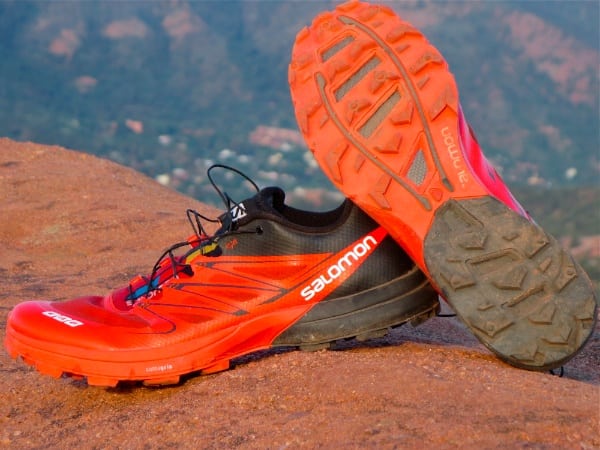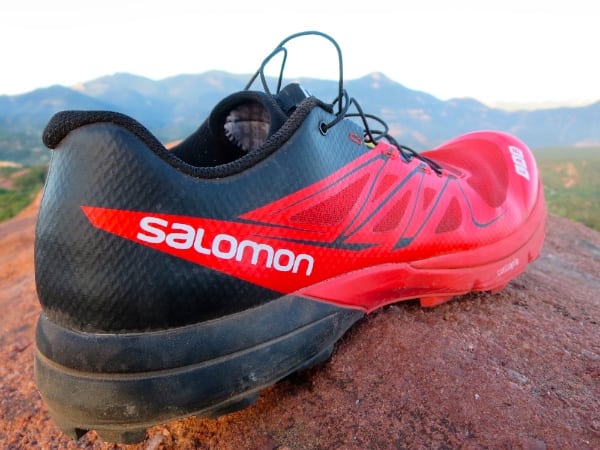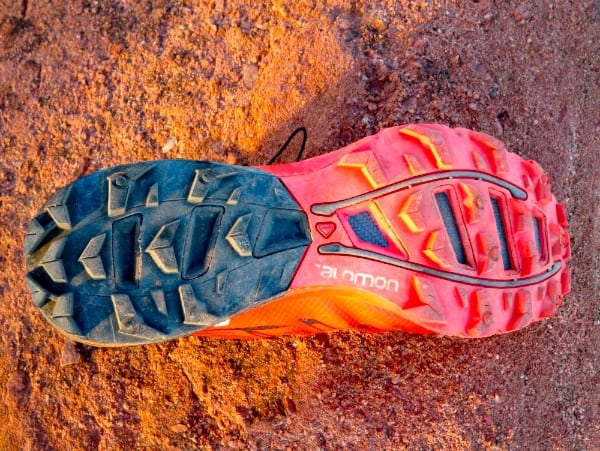Our Favorite Trail Running Shoes
Check out our Best Trail Running Shoes article to learn about our current favorite trail running shoes!
Salomon S-Lab Sense 3 Ultra Softground Review
Thirteen months ago I reviewed the original Salomon Sense Ultra, raving about the sock-like fit, nimble performance, and surprisingly effective rock plate. I ended that review with the following request, “I would love to see a Softground version of the Sense Ultra, similar to what Salomon did with the S-Lab XT 5, where softer EVA was used for harder terrain.”
I found out later that I misunderstood the intention of the Softground design, but to my feet, the extra bit of outsole seemed to add just a bit of cushioning that helped on the hard and rocky terrain I’m typically running on in Colorado. In fact, Salomon designs Softground versions of their shoes to tackle softer and muddier terrain with a grippier, more heavily lugged outsole.
As it turns out Salomon athletes also requested a Softground version of the Sense Ultra which became the Salomon S-Lab Sense 3 Ultra Softground ($160) and which, along with the Sense 3, seem to be the racing shoe of choice for most of the international team regardless of the distance. Salomon accomplished this by combining the upper and midsole of the Sense Ultra with the ever-popular outsole of the Speedcross, and the result is a shoe really able to take on any type of terrain out there.
Upper
What can I say about the upper of the Sense 3 Ultra Softground that I haven’t said in the past? Shoe porn? You bet. Beautiful lines, simple yet elegant design, a fit that almost negates the need for laces? Yep. This is one of the only trail shoes that I’ve been able to wear sockless for longer than 10 miles, and the Endofit sleeve in the interior absolutely hugs and stabilizes the foot inside the shoe. The tongue is nicely padded and protects well from the kevlar lacing system, and the lace garage opening faces the toe of the shoe, the only design that makes sense. One small problem with this design is that when the laces are cinched down for use they completely cover the lace garage and it takes considerable wrestling with the tab on the top of the pocket to pull it clear of the laces to allow for stowage. But, I don’t care how conventional you are, Salomon’s Quicklace system is the best on the market and I love that I can dial in the fit a bit on runs by loosening the laces instantly if my feet are swelling or if I’m wearing a thicker pair of running socks. I have yet to experience any loosening or slippage in the lacing system.
Sensifit overlays surround the foot, providing additional structure and durability and also keep a good deal of dust out of the shoe. These welded-on overlays flow seamlessly into the rand and rubber toecap at the front of the shoe that is surprisingly protective. Salomon uses a new, more durable mesh throughout the upper of the Sense Ultra Softground and areas of high wear are now protected with extension of the welded overlay to the footbed. After about 200 miles, my Sense 3 Ultra Softgrounds show zero wear on the upper. They wash off nicely and look like they’re straight out of the box. Overall, the Sense Ultra Softground is a very aesthetically pleasing shoe, and Salomon has created an instantly recognizable calling card by sticking with the De Stijl palate of red and black.
Midsole
With the original Sense Ultra, Salomon created a slightly higher-durometer (read: denser) midsole, and there aren’t any changes here. This midsole is on the firm side of the spectrum for trail shoes and on softer trails this firmness feels great. On hardpack I tend to get a bit beat up, but the Softground lugs lend just that extra bit of cushioning giving the Softground the more-cushioned feel. Now, durometer is entirely a personal preference, and I have running buddies that feel that the cushioning on the Sense 3 Ultra feels ‘soft,’ so take my judgment with a grain of salt. The bonus to this high-durometer midsole material is that it seems to compress at a very slow rate allowing a long life for the shoe. Also, the combination of this harder midsole and the Pro-Feel Film rock plate make the Sense 3 Ultra Softground very protective. The shoe maintains the 4mm heel drop of its sister models in the line.
Outsole
Salomon uses its Mud and Snow ContaGrip outsole on the Sense 3 Ultra Softground, and this is a fantastic addition to the shoe. Not only does the extra outsole lugging seem to add just a bit more cushioning which my feet crave in this shoe, but the traction is highly versatile. I spent a lot of time running through snow, mud, and soft clay this winter/spring in the Sense 3 Ultra Softground, and the 5mm chevron-shaped lugs are spaced widely enough apart to shed even the stickiest wet clay. The higher lugs can take a bit of getting used to while running on highly rocky terrain as they did tend to throw off my balance at times, but then again, I was running on terrain that is completely contrary to their intended use.
Overall Impression
Salomon often makes such subtle changes to their models from one year to the next that I have to hold the shoes side by side to notice the design changes. This was the case with the Sense Ultra and the Sense 3 Ultra Softground. However, the added durability in the upper will extend the life of the shoe significantly. When I think of Salomon’s trail-shoe line I imagine the specific types of terrain and conditions that each shoe was designed for. It is easy to look at the similarities between various models offered from Salomon and feel that some of them may be unnecessary. But, spend some time in the shoe on the intended terrain and you begin to realize what Salomon is trying to dial in. The Sense 3 Ultra Softground offers incredible feel and control on soft and muddy trails.
I am probably a complete anomaly, but I most often used the Sense 3 Ultra Softground on hardpack and rocky trails. Why? Because the extra bit of cushioning from the lugs gives my feet a bit more forgiveness than the original Sense Ultra. I was able to extend the distance I could run in these shoes, and although I still so very badly want to race a 50 miler in them, I feel that it is not to be for me. On a soft and muddy course this would be a go-to shoe, but on harder trails the dense midsole leaves me personally feeling a bit ginger footed.
If you live in an area with a lot of moisture, grassy or muddy trails, and steep climbs and descents, this could be your go-to shoe. However, don’t write off this model because it’s a Softground. I was pleasantly surprised by just how diverse of a performer this shoe is, and with the price point slowly creeping back toward the stratosphere, combined with increased durability, the Sense 3 Ultra Softground deserves a test run.
Call for Comments (from Meghan)
- Have you run in the Sense 3 Ultra Softground? What are your impressions?
- For those of you who have tried this shoe, how did you find it performed in various conditions?
- Is there anyone else out there who, like Tom, appreciates the lug’s extra softness on an otherwise high-durometer outsole?




